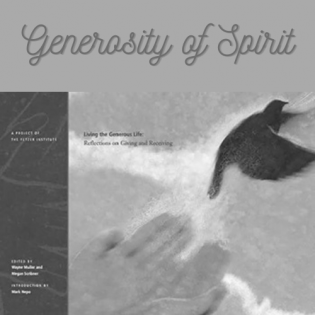Gifts of All Sizes
As demonstrated in these folktales, even the smallest things, when shared, can be examples of philanthropy.
The learner will:
- identify the historical and geographic settings of folktales.
- identify the message and connections to philanthropy.
- analyze the lower and upper limits of generosity.
Youth access to these folktales (Learning to Give has permission to make these folktales available online to readers):
Discuss whether having a generous heart is a learned trait or comes naturally.
- "The Brave Little Parrot." Martin, Rafe. The Hungry Tigress: Buddhist Legends and Jakata Tales. Berkeley, California: Parallax Press, ©1990. Used with the permission of Parallax Press. www.parallax.org "Reprinted from The Hungry Tigress (1990) by Rafe Martin with permission of Parallax Press, Berkeley, California."
- "The Drum", An Indian folktale about a boy who gives away his possions to help others.
- "The Luck of a Child." Sabar, Yona. The Folk Literature of the Kurdistani Jews: An Anthology. New Haven and London: Yale University Press, ©1982. p. 153-55. Used with the permission of Yale University Press. www.yale.edu/yup/
- "Ma’Ruf the Shoemaker." Muhawi, Ibrahim and Sharif Kanaana. Speak Bird, Speak Again: Palestinian Arab Folktales. Berkeley: University of California Press, ©1989. pp. 267-72. Used with the permission of University of California Press.
- "Sedge Hats for Jizo." Mayer, Fanny Hagin. Ancient Tales in Modern Japan. Bloomington: Indiana University Press, ©1985. p. 87. Used with the permission of Indiana University Press. www.indiana.edu
- "The Silk Brocade." Batt, Tanya Robyn. The Fabrics of Fairytale: Stories Spun Far and Wide. New York: Barefoot Books, ©2000. pp. 30-38. Used with the permission of Barefoot Books, Inc. "The Silk Brocade,’ from The Fabrics of Fairytales: Stories Spun Far and Wide, first published in 2000 by Barefoot Books, Inc. Text copyright ©2000 by Tanya Royn Batt." www.barefootbooks.com
- "The Tatema." Wolkstein, Dianne. Lazy Stories. New York: The Seabury Press: Clarion Books, ©1976. pp. 15-23. Used with the permission of Clarion Books, an imprint of Houghton Mifflin Company. "’The Tatema’ from LAZY STORIES retold by Dianne Wilkstein, pictures by James Marshall. Text copyright © 1976 by Dianne Wolkstein. Pictures copyright ©1976 by James Marshall. Reprinted by permission of Clarion Books, an imprint of Houghton Mifflin Company. All rights reserved." www.hmco.com
Instructions
Anticipatory Set:
Ask the learners if they know anyone who seems to be "naturally" generous. What characteristics about this person give that impression?
The first two stories come from India and Palestine. On a map, locate their absolute locations (longitude and latitude) and relative locations (general descriptors of where the place is located). Describe their physical characteristics and human characteristics.
Read the story "The Drum" together and discuss the message and connection to philanthropy.
- Each time the boy voluntarily gave up his possession, what was the next best alternative that he gave up? This was the opportunity cost.
- Describe the boy's character. Were his acts "naturally" generous or was his generosity a means to an end?
- If generosity is a learned behavior, how is it taught?
- What is the lesson of the folktale?
Ask for volunteers to read the parts of the various characters from the story "Ma’Ruf the Shoemaker." Read the story out loud.
- Describe Ma'ruf's character at the beginning of the story.
- Is Ma’ruf generous, foolish, or a "show-off" who likes the attention he receives?
- Does Ma’ruf deserve the "happy ending" that the storyteller gives him? Is he a generous character at the end of the story?
- What were some of the opportunity costs Ma’ruf gave up?
- What does this story say about the limits of generosity?
- Compare the two main characters in the "The Drum" and "Ma’Ruf the Shoemaker."
The folktales, "The Brave Little Parrot," "The Luck of a Child," and "Sedge Hats for Jizo," are about small gifts that are nevertheless very generous.
- Compare the characters in the three folktales.
- Discuss why it is important for even small gifts to be offered as a form of generosity.
Read "The Silk Brocade" and "The Tatema" and discuss the message and connection to philanthropy.
- In what ways are these stories opposites of each other?
- Why do you think the lazy man was rewarded in The Tatema? What is the lesson of this story?
- What is the lesson in the Silk Brocade? Is it good to put yourself in danger to help others?
Learners update the story to reflect a modern tale that gives the same lesson.
Philanthropy Framework
-
Strand PHIL.II Philanthropy and Civil Society
-
Standard PCS 03. Philanthropy and Economics
-
Benchmark HS.3 Explain how <i>opportunity cost</i> relates to philanthropic giving by individuals and corporations.
-
-
-
Strand PHIL.III Philanthropy and the Individual
-
Standard PI 01. Reasons for Individual Philanthropy
-
Benchmark HS.1 Define and give examples of motivations for giving and serving.
-
-
